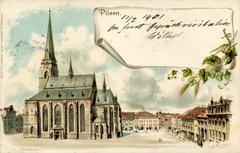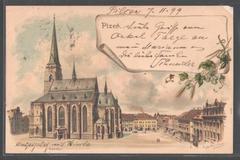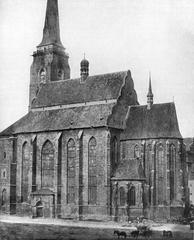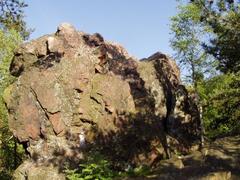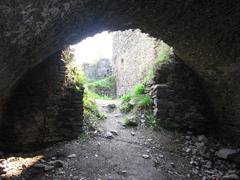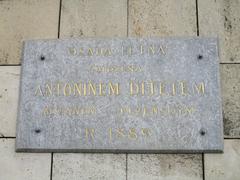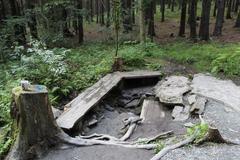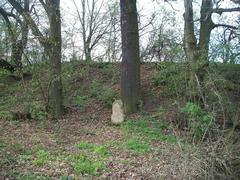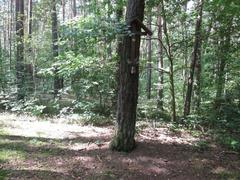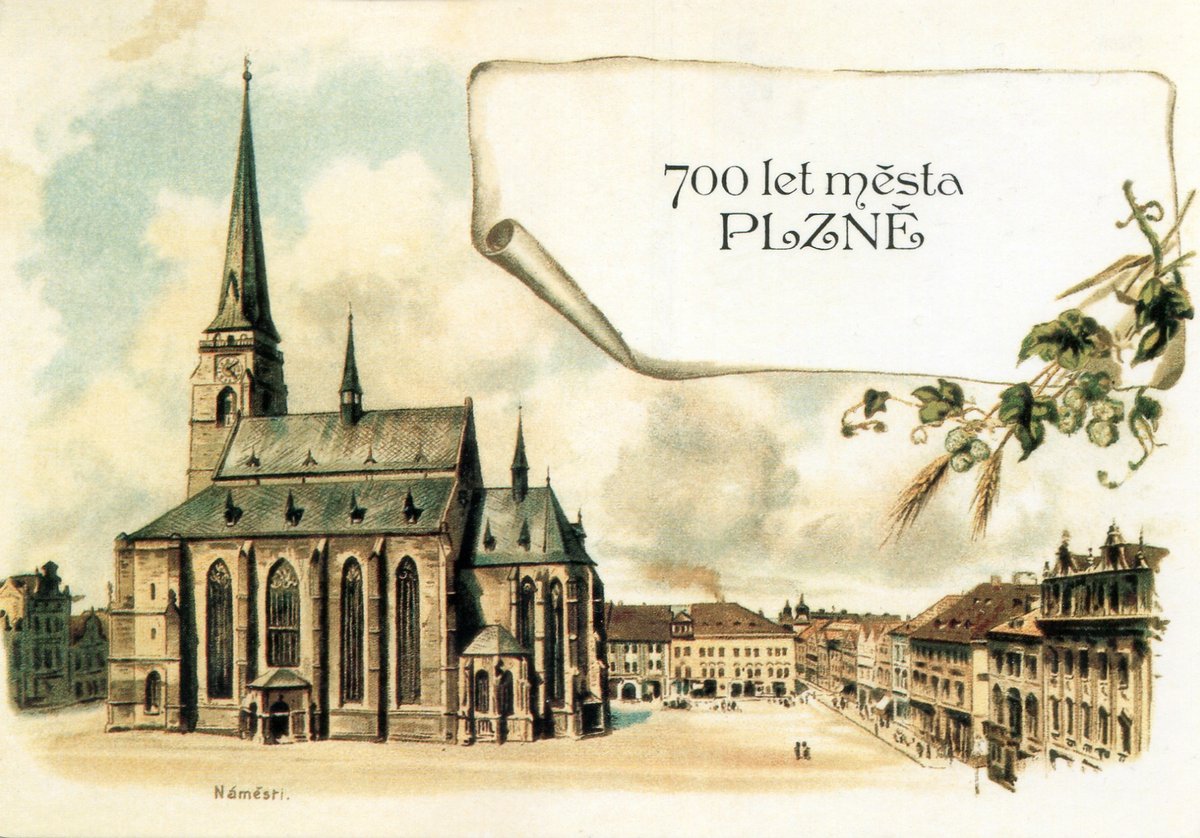
Svatý Bartoloměj Cathedral: Visiting Hours, Tickets, and Historical Significance
Date: 18/07/2024
Introduction
Welcome to the Svatý Bartoloměj Cathedral in Plzeň, Czech Republic—a beacon of religious heritage and a marvel of architectural splendor. Nestled in the heart of Plzeň, this iconic Gothic structure dates back to the 13th century, standing as a testament to the city’s rich historical tapestry. The cathedral, with its towering spire, not only dominates the Plzeň skyline but also embodies the resilience and spiritual fervor of its community (source). From its early beginnings under King Wenceslaus II to its elevation as a cathedral in the 19th century, Svatý Bartoloměj has witnessed and withstood the tides of history, including the tumultuous Hussite Wars and the transformative Protestant Reformation. Today, it continues to be a vital center of religious, cultural, and communal activities, drawing visitors from across the globe to its hallowed halls. This guide aims to provide a comprehensive look at the cathedral’s storied past, architectural marvels, and essential visitor information to enhance your experience.
Table of Contents
- [Introduction](#introductionintroduction)
- [History and Significance of Svatý Bartoloměj Cathedral](#history-and-significance-of-svatý-bartoloměj-cathedralhistory-and-significance-of-svatý-bartoloměj-cathedral)
- [Early Beginnings (13th - 15th Century)](#early-beginnings-13th---15th-centuryearly-beginnings-13th---15th-century)
- [Reformation and Renaissance (16th - 18th Century)](#reformation-and-renaissance-16th---18th-centuryreformation-and-renaissance-16th---18th-century)
- [From Parish Church to Cathedral (19th - 20th Century)](#from-parish-church-to-cathedral-19th---20th-centuryfrom-parish-church-to-cathedral-19th---20th-century)
- [Svatý Bartoloměj Today - A Symbol of Resilience and Faith](#svatý-bartoloměj-today---a-symbol-of-resilience-and-faithsvatý-bartoloměj-today---a-symbol-of-resilience-and-faith)
- [Architectural Significance](#architectural-significancearchitectural-significance)
- [Gothic Grandeur](#gothic-grandeurgothic-grandeur)
- [Renaissance Refinement](#renaissance-refinementrenaissance-refinement)
- [Baroque Flourishes](#baroque-flourishesbaroque-flourishes)
- [Visitor Information](#visitor-informationvisitor-information)
- [Visiting Hours](#visiting-hoursvisiting-hours)
- [Tickets and Guided Tours](#tickets-and-guided-tourstickets-and-guided-tours)
- [Travel Tips](#travel-tipstravel-tips)
- [Accessibility](#accessibilityaccessibility)
- [Unique Aspects and Events](#unique-aspects-and-eventsunique-aspects-and-events)
- [Cultural and Religious Significance](#cultural-and-religious-significancecultural-and-religious-significance)
- [A Spiritual Center](#a-spiritual-centera-spiritual-center)
- [A Community Hub](#a-community-huba-community-hub)
- [A Symbol of Plzeň](#a-symbol-of-plzeňa-symbol-of-plzeň)
- [Conclusion](#conclusionconclusion)
- [FAQ](#faqfaq)
- [Call to Action](#call-to-actioncall-to-action)
- [References](#referencesreferences)
History and Significance of Svatý Bartoloměj Cathedral
While the exact origins of the Svatý Bartoloměj Cathedral remain shrouded in time, historical records and archaeological findings paint a vivid picture of its enduring legacy.
Early Beginnings (13th - 15th Century)
The story of Svatý Bartoloměj begins in the heart of the 13th century, intertwined with the very foundation of Plzeň itself. As the city flourished under the rule of King Wenceslaus II, a grand Gothic church began to take shape, likely around the year 1295. This early structure, smaller and less elaborate than the cathedral we see today, served as a testament to the burgeoning city’s piety and ambition.
Over the next two centuries, Svatý Bartoloměj witnessed periods of both growth and turmoil. The church’s development mirrored the city’s own, with expansions and renovations reflecting Plzeň’s growing prosperity. However, the tumultuous Hussite Wars of the 15th century left their mark, with the church suffering damage during this period of religious upheaval.
Reformation and Renaissance (16th - 18th Century)
The winds of change swept through Europe in the 16th century, bringing with them the Protestant Reformation. Plzeň, a city with a history of religious independence, embraced these changes, and Svatý Bartoloměj became a Protestant church in 1507. This shift in denomination had a significant impact on the church’s interior, with many of the elaborate Catholic decorations removed or simplified in line with Protestant beliefs.
Despite the religious changes, Svatý Bartoloměj continued to hold a central place in the life of the city. The 16th and 17th centuries saw Plzeň thrive as a center of trade and craftsmanship, and the church benefited from this prosperity. Renovations and additions continued, reflecting the architectural styles of the Renaissance and later the Baroque period.
From Parish Church to Cathedral (19th - 20th Century)
The 19th century brought about a significant change in the status of Svatý Bartoloměj. With the establishment of the Diocese of Plzeň in 1993, the church was elevated to the rank of a cathedral, marking a new chapter in its long history. This change reflected the growing importance of Plzeň as a regional center and solidified Svatý Bartoloměj’s position as a prominent religious landmark.
The 20th century was a time of both challenges and triumphs for the cathedral. The two World Wars and the subsequent communist regime in Czechoslovakia left their mark, with the cathedral facing periods of neglect and limited resources for upkeep. However, the spirit of the community and the dedication of those who cared for Svatý Bartoloměj ensured its survival.
Svatý Bartoloměj Today - A Symbol of Resilience and Faith
Today, Svatý Bartoloměj stands as a proud symbol of Plzeň’s resilience and enduring faith. Having weathered centuries of change, conflict, and transformation, the cathedral remains a vital center of religious life and a testament to the city’s rich history. Its soaring spire, a defining feature of the Plzeň skyline, serves as a beacon, drawing visitors and locals alike to its hallowed halls.
Architectural Significance
Svatý Bartoloměj’s architectural significance lies in its fascinating blend of styles, reflecting the various periods of its construction and renovation.
Gothic Grandeur
The cathedral’s core structure, with its pointed arches, ribbed vaults, and soaring ceilings, speaks to the grandeur of Gothic architecture prevalent during its initial construction. The use of light and space, characteristic of the Gothic style, creates an atmosphere of awe and reverence within the cathedral.
Renaissance Refinement
The influence of the Renaissance can be seen in later additions and renovations, particularly in the detailing and ornamentation. The use of more classical elements, such as rounded arches and decorative motifs, adds a layer of elegance and sophistication to the cathedral’s facade.
Baroque Flourishes
The Baroque period, known for its dramatic flair, also left its mark on Svatý Bartoloměj. The ornate high altar, a masterpiece of Baroque craftsmanship, serves as a focal point within the cathedral’s interior. The intricate carvings, gilded details, and dynamic composition of the altar exemplify the opulence and grandeur characteristic of the Baroque style.
Visitor Information
Visiting Hours
Svatý Bartoloměj Cathedral is open to visitors daily from 9:00 AM to 6:00 PM. Please note that visiting hours may vary on religious holidays and special occasions.
Tickets and Guided Tours
Admission to the cathedral is free, but donations are welcome to support its upkeep. Guided tours are available for a fee and offer a deeper insight into the cathedral’s history and architecture. Tours can be booked in advance through the cathedral’s official website.
Travel Tips
The cathedral is centrally located in Plzeň and is easily accessible by public transportation. Parking is available nearby for those traveling by car. Visitors are encouraged to wear respectful attire, as Svatý Bartoloměj is an active place of worship.
Accessibility
The cathedral is wheelchair accessible, with ramps and designated seating areas for visitors with mobility challenges.
Unique Aspects and Events
Svatý Bartoloměj hosts a variety of special events throughout the year, including religious ceremonies, concerts, and cultural festivals. The cathedral’s stunning interior and exterior also make it a popular spot for photography, particularly during the golden hour.
Cultural and Religious Significance
Beyond its architectural splendor, Svatý Bartoloměj holds deep cultural and religious significance for the people of Plzeň and the Czech Republic.
A Spiritual Center
As the seat of the Diocese of Plzeň, the cathedral serves as the spiritual heart of the region, hosting important religious services and events. It is a place of pilgrimage, drawing visitors from across the country and beyond who come to pray, reflect, and connect with their faith.
A Community Hub
Throughout its history, Svatý Bartoloměj has been more than just a place of worship. It has served as a gathering place for the community, hosting concerts, lectures, and other cultural events. The cathedral’s role as a community hub underscores its importance as a place of shared heritage and social connection.
A Symbol of Plzeň
The cathedral’s towering spire, visible from across the city, has become an iconic symbol of Plzeň itself. It represents the city’s history, its resilience, and its enduring spirit. For the people of Plzeň, Svatý Bartoloměj is not just a building but a living embodiment of their shared identity and heritage.
Conclusion
Svatý Bartoloměj Cathedral is more than just a historical monument; it is a living testament to the resilience, faith, and cultural richness of Plzeň. Having weathered centuries of change, conflict, and transformation, the cathedral remains a vital center of religious life and a testament to the city’s rich history. Its soaring spire, a defining feature of the Plzeň skyline, serves as a beacon, drawing visitors and locals alike to its hallowed halls. Whether you are drawn by its architectural beauty, its deep spiritual significance, or its role as a community hub, a visit to this remarkable cathedral is sure to be a memorable experience. Plan your visit to Svatý Bartoloměj Cathedral today and explore the heart of Plzeň’s spiritual and historical heritage (source).
FAQ
Q: What are the visiting hours for Svatý Bartoloměj Cathedral?
A: The cathedral is open daily from 9:00 AM to 6:00 PM, though hours may vary on religious holidays and special occasions.
Q: Is there an admission fee?
A: Admission is free, but donations are appreciated. Guided tours are available for a fee.
Q: How can I book a guided tour?
A: Guided tours can be booked in advance through the cathedral’s official website.
Q: Is the cathedral accessible for visitors with disabilities?
A: Yes, the cathedral is wheelchair accessible and provides designated seating areas for visitors with mobility challenges.
Q: Are there any special events at the cathedral?
A: Svatý Bartoloměj hosts various events, including religious ceremonies, concerts, and cultural festivals throughout the year.
Call to Action
Plan your visit to Svatý Bartoloměj Cathedral today and explore the heart of Plzeň’s spiritual and historical heritage. For more information, download our mobile app Audiala, and stay connected with us for the latest updates on Plzeň’s cultural landmarks.

